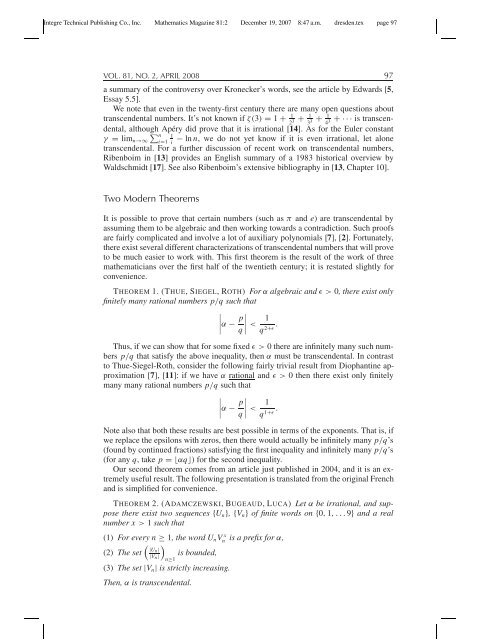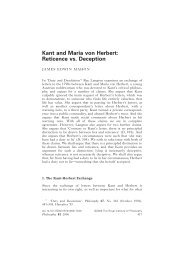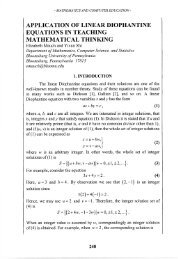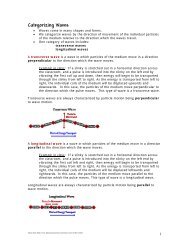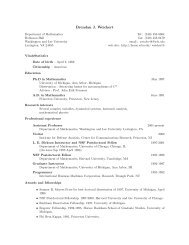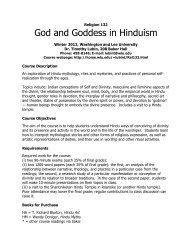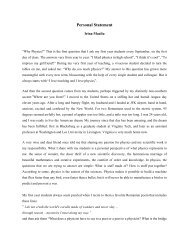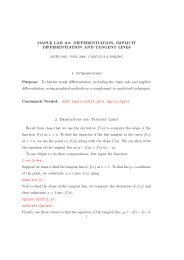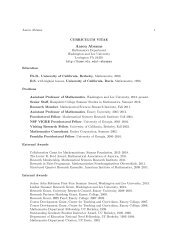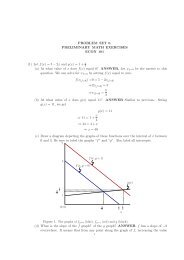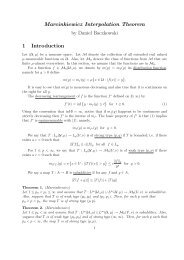Three Transcendental Numbers from the Last Non-Zero Digits of nn ...
Three Transcendental Numbers from the Last Non-Zero Digits of nn ...
Three Transcendental Numbers from the Last Non-Zero Digits of nn ...
You also want an ePaper? Increase the reach of your titles
YUMPU automatically turns print PDFs into web optimized ePapers that Google loves.
Integre Technical Publishing Co., Inc. Ma<strong>the</strong>matics Magazine 81:2 December 19, 2007 8:47 a.m. dresden.tex page 97<br />
VOL. 81, NO. 2, APRIL 2008 97<br />
a summary <strong>of</strong> <strong>the</strong> controversy over Kronecker’s words, see <strong>the</strong> article by Edwards [5,<br />
Essay 5.5].<br />
We note that even in <strong>the</strong> twenty-first century <strong>the</strong>re are many open questions about<br />
transcendental numbers. It’s not known if ζ(3) = 1 + 1 + 1 + 1 + · · · is transcendental,<br />
although ∑ Apéry did prove that it is irrational [14]. As for <strong>the</strong> Euler constant<br />
2 3 3 3 4 3<br />
γ = lim n 1<br />
n→∞ i=1<br />
− ln n, we do not yet know if it is even irrational, let alone<br />
i<br />
transcendental. For a fur<strong>the</strong>r discussion <strong>of</strong> recent work on transcendental numbers,<br />
Ribenboim in [13] provides an English summary <strong>of</strong> a 1983 historical overview by<br />
Waldschmidt [17]. See also Ribenboim’s extensive bibliography in [13, Chapter 10].<br />
Two Modern Theorems<br />
It is possible to prove that certain numbers (such as π and e) are transcendental by<br />
assuming <strong>the</strong>m to be algebraic and <strong>the</strong>n working towards a contradiction. Such pro<strong>of</strong>s<br />
are fairly complicated and involve a lot <strong>of</strong> auxiliary polynomials [7], [2]. Fortunately,<br />
<strong>the</strong>re exist several different characterizations <strong>of</strong> transcendental numbers that will prove<br />
to be much easier to work with. This first <strong>the</strong>orem is <strong>the</strong> result <strong>of</strong> <strong>the</strong> work <strong>of</strong> three<br />
ma<strong>the</strong>maticians over <strong>the</strong> first half <strong>of</strong> <strong>the</strong> twentieth century; it is restated slightly for<br />
convenience.<br />
THEOREM 1. (THUE,SIEGEL,ROTH) For α algebraic and ɛ> 0, <strong>the</strong>re exist only<br />
finitely many rational numbers p/q such that<br />
∣ α − p q ∣ < 1<br />
q . 2+ɛ<br />
Thus, if we can show that for some fixed ɛ> 0 <strong>the</strong>re are infinitely many such numbers<br />
p/q that satisfy <strong>the</strong> above inequality, <strong>the</strong>n α must be transcendental. In contrast<br />
to Thue-Siegel-Roth, consider <strong>the</strong> following fairly trivial result <strong>from</strong> Diophantine approximation<br />
[7], [11]: if we have α rational and ɛ> 0 <strong>the</strong>n <strong>the</strong>re exist only finitely<br />
many many rational numbers p/q such that<br />
∣ α − p q ∣ < 1<br />
q . 1+ɛ<br />
Note also that both <strong>the</strong>se results are best possible in terms <strong>of</strong> <strong>the</strong> exponents. That is, if<br />
we replace <strong>the</strong> epsilons with zeros, <strong>the</strong>n <strong>the</strong>re would actually be infinitely many p/q’s<br />
(found by continued fractions) satisfying <strong>the</strong> first inequality and infinitely many p/q’s<br />
(for any q, take p =⌊αq⌋) for <strong>the</strong> second inequality.<br />
Our second <strong>the</strong>orem comes <strong>from</strong> an article just published in 2004, and it is an extremely<br />
useful result. The following presentation is translated <strong>from</strong> <strong>the</strong> original French<br />
and is simplified for convenience.<br />
THEOREM 2. (ADAMCZEWSKI, BUGEAUD, LUCA) Let α be irrational, and suppose<br />
<strong>the</strong>re exist two sequences {U n }, {V n } <strong>of</strong> finite words on {0, 1,...9} and a real<br />
number x > 1 such that<br />
(1) For every n ≥ 1, <strong>the</strong> word U n Vn x is a prefix for α,<br />
)<br />
(2) The set is bounded,<br />
(<br />
|Un |<br />
|V n |<br />
n≥1<br />
(3) The set |V n | is strictly increasing.<br />
Then, α is transcendental.


